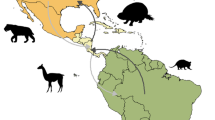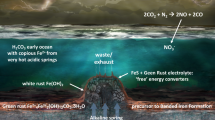Abstract
The modern attention to global and system approaches to the study of life evolution increase the interest in integrating macroevolutionary and ecological research and developing their theoretical foundations. The econ of species is suggested as an elementary fundamental unit of evolving paleobiospheric spatiotemporal continuum. The concept of econ, the unity of species and its ecological niche, allows solving issues of evolution of biodiversity, evolutionary macroecology and biogeography on spatiotemporal scales and in the framework of the system macrotaxon–biosphere. These studies need to be based on actual taxa. Therefore, a natural classification of organisms, reflecting true phylogeny, is of particular relevance. A holistic approach will allow obtaining more substantiated conclusions on the evolution and distribution of both fossil and modern organisms.

Similar content being viewed by others
REFERENCES
Blackburn, T.M. and Gaston, K.J., Macroecology: Concepts and Consequences, Oxford: Blackwell, 2003.
Brown, J.H., Macroecology, Chicago: Univ. Chicago Press, 1995.
Brown, J.H. and Maurer, B.A., Macroecology: The division of food and space among species on continents, Science, 1989, vol. 243, pp. 1145–1150.
Carotenuto, F., Barbera, C., and Raia, P., Occupancy, range size, and phylogeny in Eurasian Pliocene to Recent large mammals, Paleobiology, 2010, vol. 36, pp. 399–414.
Carotenuto, F., Diniz-Filho, J.A.F., and Raia, P., Space and time: The two dimensions of Artiodactyla body mass evolution, Palaeogeogr., Palaeoclimatol., Palaeoecol., 2015, vol. 437, pp. 18–25.
Castiglione, S., Mondanaro, A., Carotenuto, F., et al., The many shapes of diversity: ecological and evolutionary determinants of biodiversity through time, Evol. Ecol. Res., 2017, vol. 18, pp. 25–39.
Cavender-Bares, J., Kozak, K.H., Fine, P.V.A., and Kembel, S.W., The merging of community ecology and phylogenetic biology, Ecol. Lett., 2009, vol. 12, pp. 693–715.
Chase, J.M. and Leibold, M.A., Ecological Niches: Linking Classical and Contemporary Approaches, Chicago: Univ. Chicago Press, 2003.
Darlington, P.J., Zoogeography: The Geographic Distribution of Animals, Cambridge: Harvard Univ. Press, 1957.
Darwin, Ch., The Origin of Species by Means of Natural Selection or the Preservation of Favoured Races in the Struggle for Life, London: J. Murray, 1859.
Dzunino, M. and Dzullini, A., Biogeografiya (evolyutsionnye aspekty) (Biogeography: Evolutionary Aspects), Moscow: Mosk. Gos. Univ., 2010.
Fortelius, M., Eronen, J., Liu, L., et al., Late Miocene and Early Pliocene large land mammals and climatic changes in Eurasia, Palaeogeogr., Palaeoclimatol., Palaeoecol., 2006, vol. 238, pp. 219–227.
Grinnell, J., The niche relationships of the California thrasher, Auk, 1917, vol. 34, pp. 427–433.
Heatwole, H., The concept of the econe, a fundamental ecological unit, Trop. Ecol., 1989, vol. 25, no. 1, pp. 13–19.
Hennig, W., Phylogenetic Systematics, Urbana: Illinois Univ. Press, 1966.
Hubert, N., Calcagno, V., Ettiene, S., and Mouquet, N., Metacommunity speciation models and their implications for diversification theory, Ecol. Lett., 2015, vol. 18, pp. 864–881.
Hunt, G., The relative importance of directional change, random walks, and stasis in the evolution of fossil lineages, Proc. Natl. Acad. Sci. USA, 2007, vol. 104, pp. 18404–18408.
Hunt, G., Hopkins, M.J., and Lidgard, S., Simple versus complex models of trait evolution and stasis as a response to environmental change, Proc. Natl. Acad. Sci. USA, 2015, vol. 112, pp. 4885–4890.
Hutchinson, G.E., Concluding remarks, Cold Spring Harbor Sym. Quant. Biol., 1957, vol. 22, pp. 415–427.
Jablonski, D., Lessons from the past: Evolutionary impacts of mass extinctions, Proc. Natl. Acad. Sci. USA, 2001, vol. 98, pp. 5393–5398.
Jablonski, D., Evolutionary innovations in the fossil record: The intersection of ecology, development, and macroevolution, J. Exp. Zool., 2005, vol. 304B, pp. 504–519.
Jablonski, D., Benton, M.J., Gastaldo, R.A., et al., Macroevolution in the 21st century, Kleine Senckenbergreihe, 1997, vol. 25 (Paleontology in the 21st Century Workshop, Lane, H.R., Lipps, J., Steininger, F.F., and Ziegler, W., Eds.,), pp. 111–119.
Kembel, S.W., Disentangling niche and neutral influences on community assembly: Assessing the performance of community phylogenetic structure tests, Ecol. Lett., 2009, vol. 12, pp. 949–960.
Kowalevsky, V.O., Osteology of two fossil species from the ungulate group, Entelodon and Gelocus, Izv. Imp. Ob-va Lyubit. Estestvoznan. Antropol. Etnogr., 1875, vol. 16, pp. 1–59.
Laland, K., Matthews, B., and Feldman, M.W., An introduction to niche construction theory, Evol. Ecol., 2016, vol. 30, pp. 191–202.
Lewontin, R.C., The organism as the subject and object of evolution, Scientia, 1983, vol. 118, pp. 63–82.
Lidicker, W.Z., Levels of organization in biology, Biol. Rev., 2008, vol. 83, pp. 71–78.
Lieberman, B.S., Miller, W.III., and Eldredge, N., Paleontological patterns, macroecological dynamics and the evolutionary process, Evol. Biol., 2007, vol. 34, pp. 28–48.
Lima-Ribeiro, M.S. and Diniz-Filho, J.A.F., Climate change, human overkill, and the extinction of megafauna: A macroecological approach based on pattern-oriented modeling, Evol. Ecol. Res., 2017, vol. 18, pp. 97–121.
Losos, J.B., Adaptive radiation, ecological opportunity, and evolutionary determinism, Am. Natur., 2010, vol. 175, pp. 623–639.
MacArthur, R., The theory of the niche, in Population Biology and Evolution, Lewontin, R.C., Ed., Syracuse: Syracuse Univ. Press, 1968, pp. 159–176.
MacArthur, R., Geographical Ecology: Patterns in the Distribution of Species, New York: Harper and Row, 1972.
Mayr, E., Cladistic analysis or cladistics classification, Z. Zool. Syst. Evol. Forsch., 1974, vol. 12, no. 2, pp. 94–128.
Mayr, E., The Growth of Biological Thought: Diversity, Evolution, and Inheritance, Cambridge: Belknap Press, 1982.
Mayr, E., Towards a New Philosophy of Biology: Observation of an Evolutionist, Cambridge: Belknap Press, 1988.
McGowen, M.R., Gatesy, J., and Wildman, D.E., Molecular evolution tracks macroevolutionary transition in Cetacea, Trends Ecol. Evol., 2014, vol. 29, pp. 336–346.
Meszéna, G. and Hendry, A.P., Introduction to niche theory and speciation, Evol. Ecol. Res., 2012, vol. 14, pp. 361–363.
Palombo, M.R., Valli, A., Kostopoulos, D.S., et al., Similarity relationships between the Pliocene to Middle Pleistocene large mammal faunas of Southern Europe from Spain to the Balkans and the North Pontic Region, Cour. Forsch. Senckenb., 2006, vol. 256, pp. 329–347.
Pavlinov, I.Ya., Kladisticheskii analiz (metodologicheskie problemy) (Cladistic Analysis: Methodological Problems), Moscow: Mosk. Gos. Univ., 1990.
Pavlinov, I.Ya., Vvedenie v sovremennuyu filogenetiku (kladogeneticheskii aspekt) (Introduction to Modern Phylogenetics: Cladogenetic Aspect), Moscow: KMK, 2005.
Pearse, W.D., Purvis, A., Cavender-Bares, J., and Helmus, M.R., Metrics and models of community phylogenetics, in Modern Phylogenetic Comparative Methods and Their Application in Evolutionary Biology, Garamszegi, L.Z., Ed., Berlin: Springer, 2014, pp. 451–464.
Pocheville, A., The ecological niche: History and recent controversy, in Handbook of Evolutionary Thinking in the Sciences, Heams, T., Huneman, P., Lecointre, G., and Silberstein, M., Eds., Dordrecht: Springer, 2015, pp. 547–586.
Polly, P.D., Fuentes-Gonzalez, J., Lawing, A.M., et al., Clade sorting has a greater effect than local adaptation on ecometric patterns in Carnivora, Evol. Ecol. Res., 2017, vol. 18, pp. 61–95.
Rabosky, D.L., Ecological limits on clade diversification in higher taxa, Am. Natur., 2009, vol. 173, pp. 662–674.
Raia, P. and Fortelius, M., Evolutionary macroecology, Evol. Ecol. Res., 2017, vol. 18, pp. 1–6.
Rasnitsyn, A.P., Chronicle and cladogram, in Evolyutsiya biosfery i bioraznoobraziya (Evolution of the Biosphere and Biodiversity), Moscow: KMK, 2006, pp. 39–48.
Ricklefs, R.E., History and diversity: Explorations at the intersection of ecology and evolution, Am. Natur., 2007, vol. 170, pp. S56–S70.
Sahney, S., Benton, M.J., and Ferry, P.A., Links between global taxonomic diversity, ecological diversity and the expansion of vertebrates on lands, Biol. Lett., 2010, vol. 6, no. 4, pp. 544–547.
Schmalhausen, I.I., Puti i zakonomernosti evolyutsionnogo protsessa (Pathways and Patterns of the Evolutionary Process), Moscow–Leningrad: Akad. Nauk SSSR, 1940.
Schmalhausen, I.I., Stabilizing selection and its place among factors of evolution, Zhurn. Obshch. Biol., 1941, vol. 2, no. 3, pp. 307–354.
Sepkoski, J.J., Biodiversity: Past, present, and future, J. Paleontol., 1997, vol. 71, pp. 533–539.
Sepkoski, J.J., Bambach, R.K., Raup, D.M., and Valentine, J.W., Phanerozoic marine diversity and the fossil record, Nature, 1981, vol. 293, pp. 435–437.
Severtsov, A.N., Glavnye napravleniya evolyutsionnogo protsessa (Mainstream of the Evolutionary Process), Moscow: Dumnova, 1925.
Silvestro, D., Pires, M.M., Quental, T.B., and Salamin, N., Bayesian estimation of multipleclade competition from fossil data, Evol. Ecol. Res., 2017, vol. 18, pp. 41–59.
Simpson, G.G., Tempo and Mode in Evolution, New York: Columbia Univ. Press, 1944.
Simpson, G.G., The Principle of Animal Taxonomy, New York: Columbia Univ. Press, 1961.
Simpson, G.G., Why and How: Some Problems and Methods in Historical Biology, New York: Pergamon Press, 1980.
Teilhard de Chardin, P., Le phénoméne humain, Paris: Du Seuil, 1955.
Valentine, J.W. and Jablonski, D., Morphological and developmental macroevolution: A paleontological perspective, Int. J. Develop. Biol., 2003, vol. 47, nos. 7–8, pp. 517–522.
Van Valen, L., Adaptive zones and the orders of mammals, Evolution, 1971, vol. 25, no. 2, pp. 120–128.
Van Valen, L., Why not to be a cladist, Evol. Theory, 1978, vol. 3, pp. 285–294.
Vavilov, N.I., Law of homologous series in hereditary variation, in Trudy Vserossiiskogo s’’ezda po selektsii i semenovodstvu (Proceedings of the Congress on Selection and Seedage), Saratov, Gubpoligrafotdel, 1920, pp. 41-‒56.
Vavilov, N.I., Law of homologous series in hereditary variation, in Teoreticheskoe osnovy selektsii rastenii (Theoretical Foundation of Plant Selection), Moscow–Leningrad, 1935, vol. 1, pp. 75–128.
Vislobokova, I.A., Fossil deer of Eurasia, Tr. Paleontol Inst. Akad. Nauk SSSR, 1990, vol. 240, pp. 1–208.
Vislobokova, I.A., Historical development of Artiodactyla in Northern Eurasia and evolutionary stages of their communities in the Cenozoic, in Evolyutsiya biosfery i bioraznoobraziya (Evolution of the Biosphere and Biodiversity), Moscow: KMK, 2006, pp. 416–438.
Vislobokova, I.A., The main stages in the evolution of artiodactyl communities of northern Eurasia in the Pliocene–beginning of the Middle Pleistocene: Part 1, Paleontol. Zh., 2008a, no. 3, pp. 76–91.
Vislobokova, I.A., The main stages in the evolution of artiodactyl communities of northern Eurasia in the Pliocene–beginning of the Middle Pleistocene: Part 2, Paleontol. Zh., 2008b, no. 4, pp. 79–89.
Vislobokova, I.A., Giant deer: Origin, evolution, role in the biosphere, Paleontol. J., 2012, vol. 46, no. 7, pp. 643–775.
Vislobokova, I.A., On the origin of Cetartiodactyla: Comparison of the data of evolutionary morphology and molecular biology, Paleontol. Zh., 2013a, no. 3, pp. 83–97.
Vislobokova, I.A., Ecological evolution of early Cetartiodactyla and reconstruction of its missing initial link, Paleontol. Zh., 2013b, no. 5, pp. 72–88.
Vislobokova, I.A., Evolyutsiya biosfery i makroevolyutsiya (Evolution of the Biosphere and Macroevolution), Moscow: GEOS, 2014.
Vislobokova, I.A., Macroevolution as a system process of the development of life, in Paleontologiya. Stratigrafiya. Astrobiologiya. K 80-letiyu akad. A.Yu. Rozanova (Paleontology, Stratigraphy, and Astrobiology: To the 80th Anniversary of the Birthday of Academician A.Yu. Rozanov), Moscow: Paleontol. Inst. Ross. Akad. Nauk, 2016, pp. 137–165.
Vislobokova, I.A., The concept of macroevolution in the light of modern data, Paleontol. J., 2017, vol. 51, no. 8, pp. 799–898.
Vrba, E.S., Mammals as a key to evolutionary theory, J. Mammal., 1992, vol. 73, pp. 1–28.
Vrba, E.S., Turnover pulses, the Red Queen, and related topics, Am. J. Sci., 1993, vol. 293, pp. 418–452.
Zelenkov, N.V., Cladistic analysis, evolution and paleontology, in Sovremennaya paleontologiya: klassicheskie i noveishie metody–2012 (Modern Paleontology: Classical and Modern Methods: 2012), Moscow: Paleontol. Inst. Ross. Akad. Nauk, 2012, pp. 9–25.
ACKNOWLEDGMENTS
This study was supported by the program of the Russian Academy of Sciences on Biosphere Evolution.
Author information
Authors and Affiliations
Corresponding author
Additional information
Translated by G. Rautian
Rights and permissions
About this article
Cite this article
Vislobokova, I.A. On New Approaches in the Study of Evolution of Macrotaxa and the Concept of Econ. Paleontol. J. 53, 1–9 (2019). https://doi.org/10.1134/S0031030119010118
Received:
Accepted:
Published:
Issue Date:
DOI: https://doi.org/10.1134/S0031030119010118




